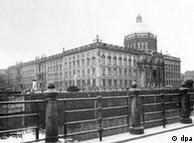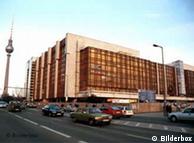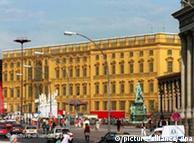Architecture | 27.11.2008
Amid Squabbling, Berlin to Reveal Imperial Palace Design
A 15-member jury is scheduled to announce the winning design for the reconstruction of Berlin's former imperial palace on Friday. As with all steps in this project, that decision is sure to attract controversy.
The eight architects and seven politicians charged with selecting the winning design from the final round of 30 applicants will make their decision known on Friday evening, Nov. 28.
Discussions in the run-up to awarding the contract for the 552 million euro ($713 million) project have been anything but harmonious. The original official tender for the imperial palace to be rebuilt, issued by the German parliament, Bundestag, in 2002, stipulated that three of its four facades had to be copies of the original baroque architecture.
The head of the jury, architect Vittorio Lampugnani, has publicly said that this put too many constraints on designers and ruled out the possibility of modern elements in the project.
"If freedom of thought is no longer allowed and jury members are not permitted to have their own opinions, then architectural competitions should just be decided by subaltern functionaries," Lampugnani told the weekly news magazine Der Spiegel.
Statements like that led some traditionalist palace supporters to call for Lampugnani's resignation. It was a querulous final planning phase in a project to restore one of the most prominent, if controversial structures in Berlin's old city center.
A very historical site
 Bildunterschrift: Großansicht des Bildes mit der Bildunterschrift: This was the original building on the site
Bildunterschrift: Großansicht des Bildes mit der Bildunterschrift: This was the original building on the site
The original imperial palace was constructed in various stages between 1443 and 1853 and served as a city residence for the Hohenzollern royal family in Prussia -- and later Wilhelmine Germany.
In the 19th and 20th centuries, it was the site for numerous protests, and in 1918, after World War I, left-wing leader Karl Liebknecht proclaimed a short-lived German socialist republic from its balcony.
The palace was hit by Allied bombs in World War II and badly damaged by fire. The leadership of communist East Germany, which viewed the building as a symbol of feudal and capitalist repression, ordered the remants torn down in 1950.
In 1975, the site was used for the construction of a new East German parliament building, an abstract modern rectangle called the "Palace of the Republic."
That building fell into disuse after German reunification and has since been dismantled over the past couple of years -- both because it was contaminated with asbestos and in order to make way for the imperial palace reconstruction.
West German appropriation
 Bildunterschrift: Großansicht des Bildes mit der Bildunterschrift: The Palace of the Republic from Communist East Germany has since been demolished
Bildunterschrift: Großansicht des Bildes mit der Bildunterschrift: The Palace of the Republic from Communist East Germany has since been demolished
The drive to rebuild the palace began in 1992 with a private initiative founded by Hamburg businessman Wilhelm von Boddien and architect Kathleen King von Alvensleben.
But the initiative immediately ignited opposition. Some objected that the heavily indebted German capital would be spending money on a prestige project; many former East Germans saw the reconstruction as an act of appropriation by their new western countrymen and an attempt to erase the East's Communist past.
The project is to be financed by a public-private partnership, and some 80 million euros will be needed to reconstruct the baroque facade.
The building is to house the Humboldt Forum, a cultural group that plans to use the space to exhibit the city of Berlin's non-European art collections. An entertainment and convention center would also be part of the complex.
But first, the jury will have to select a design. After years of fighting between city planners, traditionalists and fans of modern architecture, residents of the German capital are about to get a better idea what exactly a reconstruction of the imperial palace will look like.

Comments